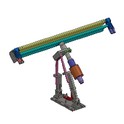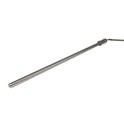Ultrasonic rings are innovative devices that have found a wide range of applications in various industries, from industrial cleaning to distance measurement. As a supplier of ultrasonic rings, I often get asked about the maximum distance these devices can measure. In this blog post, I will delve into the factors that influence the maximum measurement distance of an ultrasonic ring and provide insights based on our products, the ResoRing-30 Ultrasonic Ring and ResoRing-25 Ultrasonic Ring.


How Ultrasonic Rings Work for Distance Measurement
Before discussing the maximum measurement distance, it's essential to understand how ultrasonic rings function in distance measurement. Ultrasonic rings emit high - frequency sound waves, typically above the range of human hearing (above 20 kHz). These sound waves travel through the medium (usually air) until they hit an object. When the waves hit the object, they bounce back (echo) to the ultrasonic ring. The device then measures the time it takes for the sound wave to travel to the object and back. Using the known speed of sound in the medium, the distance to the object can be calculated using the formula:
[d=\frac{v\times t}{2}]
where (d) is the distance to the object, (v) is the speed of sound in the medium, and (t) is the time taken for the round - trip of the sound wave.
Factors Affecting the Maximum Measurement Distance
1. Transducer Power
The power of the ultrasonic transducer in the ring is a crucial factor. A more powerful transducer can emit stronger sound waves. Stronger sound waves can travel farther through the medium before their intensity drops below the detectable level. Our ResoRing - 30 Ultrasonic Ring is equipped with a high - power transducer, which allows it to emit relatively strong ultrasonic waves. This gives it an edge in measuring longer distances compared to some lower - power models.
2. Frequency of the Ultrasonic Waves
The frequency of the ultrasonic waves also plays a role. Higher - frequency waves tend to have more energy per unit area but are more easily absorbed and scattered by the medium. Lower - frequency waves can travel farther but may have lower resolution. Our ResoRing - 25 Ultrasonic Ring operates at an optimized frequency that balances the need for distance and resolution. This frequency is carefully selected to ensure that the waves can travel a reasonable distance while still providing accurate measurements.
3. Medium Properties
The properties of the medium through which the ultrasonic waves travel significantly affect the maximum measurement distance. In air, factors such as temperature, humidity, and air pressure can change the speed of sound and the absorption rate of the ultrasonic waves. For example, at higher temperatures, the speed of sound in air increases, which can slightly affect the distance calculation. Additionally, humidity can cause more absorption of the ultrasonic waves, reducing the maximum measurable distance. In other media, such as liquids or solids, the speed of sound is much higher, and the absorption characteristics are different. Our ultrasonic rings are primarily designed for use in air, but they can also be adapted for use in other media with appropriate calibration.
4. Environmental Interference
Environmental factors such as background noise, presence of obstacles, and air turbulence can interfere with the ultrasonic waves. Background noise can mask the returning echo, making it difficult for the ultrasonic ring to detect the signal. Obstacles in the path of the sound wave can cause multiple reflections, leading to inaccurate distance measurements. Air turbulence can scatter the ultrasonic waves, reducing their intensity and making it harder to measure long distances. Our ultrasonic rings are designed with advanced signal - processing algorithms to minimize the impact of these environmental factors.
Maximum Measurement Distances of Our Ultrasonic Rings
Based on our extensive testing and real - world applications, the ResoRing - 30 Ultrasonic Ring can measure distances up to approximately 30 meters in ideal conditions. Ideal conditions include a clean, still environment with minimal background noise and a clear line - of - sight to the target object. In less ideal conditions, such as a noisy industrial environment or an area with air turbulence, the maximum measurement distance may be reduced to around 20 - 25 meters.
The ResoRing - 25 Ultrasonic Ring, on the other hand, is designed for more moderate - range measurements. It can measure distances up to about 25 meters in ideal conditions. In real - world scenarios with some environmental interference, the maximum distance may be around 15 - 20 meters.
Applications and the Importance of Maximum Measurement Distance
The maximum measurement distance of an ultrasonic ring is crucial in many applications. In industrial automation, for example, ultrasonic rings are used to measure the distance between objects on a production line. A longer measurement distance allows for a wider range of applications, such as monitoring the position of large - scale equipment or measuring the height of tall storage tanks.
In robotics, ultrasonic rings can be used for obstacle detection. A greater measurement distance gives the robot more time to react to approaching obstacles, enhancing its safety and efficiency. In the field of security, ultrasonic rings can be used to detect intruders at a distance, and a longer measurement distance means a larger surveillance area.
Conclusion and Call to Action
In conclusion, the maximum distance an ultrasonic ring can measure depends on several factors, including transducer power, frequency, medium properties, and environmental interference. Our ResoRing - 30 Ultrasonic Ring and ResoRing - 25 Ultrasonic Ring are designed to provide reliable distance measurements within their specified ranges.
If you are in need of high - quality ultrasonic rings for your application, whether it's industrial automation, robotics, or security, we are here to help. Our team of experts can provide you with detailed information about our products and assist you in choosing the right ultrasonic ring for your specific requirements. Contact us to start a procurement discussion and find out how our ultrasonic rings can benefit your business.
References
- Kinsler, L. E., Frey, A. R., Coppens, A. B., & Sanders, J. V. (2000). Fundamentals of Acoustics. Wiley.
- Mechefske, C. K. (2008). Engineering Vibrations. Springer.





